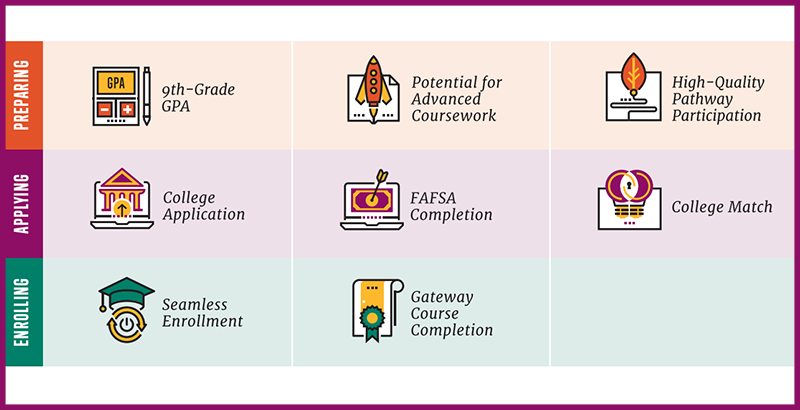Reyna: 9th-Grade Average. FAFSA Completion. College Matching. Some Key Measures for Making Sure Students Are on the Right Track

Updated Sept. 14
No one’s trajectory in life should come down to a coin flip; but for Black, brown and low-income students at approximately 7,000 high schools across the United States, chances of successfully enrolling in higher education — and opening the doors to economic mobility that come with postsecondary education — are 50 percent or less.
The impact of COVID-19 threatens to worsen long-standing equity gaps in postsecondary attainment and, ultimately, in economic mobility. Economic hardship, health and family challenges, and physical restrictions have caused millions to rethink their plans to enroll in college. Once again, students of color are disproportionately impacted; Black and Hispanic students are more likely than their white peers to have changed or canceled their education plans. These current and potential postsecondary students face a serious risk of becoming a lost COVID cohort.
A new report from Education Strategy Group sounds the alarm on the threat that “coin flip” high schools pose to millions of students and their futures, and it offers a new framework to help education leaders counter that threat. Closing gaps and bringing about a more equitable society — particularly with the devastating effects of the pandemic — means focusing on strengthening critical transition points on the journey to and through higher education. The “Momentum Metrics” outlined in the report encourage education leaders to think beyond traditional data to better prepare and support students. The potential power of these metrics is significant; unfortunately, based on ESG’s review, far too few high schools or districts have prioritized these measures to increase postsecondary preparation and success.
Here are a few of the most critical predictive measures that some schools, districts, charter networks and states across the country are using to reverse the trajectory of inequitable outcomes:
- Ninth-grade GPA: Students with a grade-point average above 3.0 in ninth grade have a 70 percent chance of maintaining or improving that number by high school graduation, which makes them significantly more likely to progress to and persist in higher education. A close focus on ninth-grade GPA helped Chicago Public Schools increase its on-track rate by over 20 percentage points in the past decade.
- FAFSA completion: Ninety percent of students who complete the Free Application for Federal Student Aid (FAFSA) successfully enroll in college immediately after high school graduation, compared with just 55 percent of non-completers. This makes it extra worrisome that this year, fewer low-income students and students of color are completing the FAFSA than in previous years. Supporting students in completing the FAFSA can substantially increase the odds that they will successfully enroll in college; Tennessee, for example, increased its FAFSA completion rate by 20 percentage points over five years through K-12 and higher education collaboration that added capacity to guide families through the application process, publicized district data on completions and created a statewide communications campaign encouraging students and families to complete the form.
- College applications: Increasing the number of applications students submit significantly boosts their probability of enrolling at a college or university, and 89 percent of students submitting at least two applications are accepted by at least one four-year institution. Through a concerted focus on college applications, between 2013 and 2018, D.C. Public Schools went from 41 percent of its high school graduates enrolling in college to 55 percent.
- College match: In a phenomenon known as undermatching, students of color and those from low-income families are more likely to attend less selective universities than their academic credentials suggest they should. These schools offer less financial aid and support services, and often have lower graduation rates, than more selective colleges. With limited ability to visit campuses and reduced access to social networks to guide their college enrollment decisions due to the pandemic, it is now more difficult for students to figure out which schools are the best fit for them. Last February, Achieve Atlanta and Atlanta Public Schools launched a tool to help district students find a match, and a third of juniors used it last spring despite COVID-19.
- Gateway course completion: Students who complete entry-level, or gateway, English and mathematics courses by the end of their first year in college are significantly more likely to persist and attain a credential. Unfortunately, far too many are placed in remedial classes and never go on to finish a gateway course. Students are much more likely to succeed through the co-requisite remediation model, in which they enroll directly in credit-bearing, college-level courses while receiving academic support. For example, after Georgia instituted a systemwide co-requisite model through its Complete College Georgia initiative, gateway course success rates in English and mathematics more than tripled compared with the traditional remediation model.
The journey to and through higher education is complex. Helping more students, especially those who are too often left behind, access and succeed in postsecondary education requires innovative approaches to monitoring and supporting their progress. With the guidance and assistance of school administrators, educators and counselors, along with the leadership of states and districts, the Momentum Metrics data can offer critical information to effectively target support to the students who need it the most. Without swift action, the pandemic will further weaken key postsecondary momentum points and derail the dreams of students and their families.
Ryan Reyna is senior director of Education Strategy Group.
Get stories like these delivered straight to your inbox. Sign up for The 74 Newsletter

;)
